(VOVworld) - Minhwa or Korea’s folk painting is an integral part of Korea’s culture. It is known to convey the mythology, religion, and views of the Korean people. This month, more than 40 pieces of Minhwa art are on display at an exhibition titled “Ancient Seoul and Korean traditional folk paintings” to introduce to people in Hanoi one of the most interesting aspects of Korean culture.
The exhibition space of the Korean Cultural Center in Hanoi these weeks looks more colorful and lively than ever. The bright colors of the works on display certainly are eye-catching. In one corner, people are admiring a large 8-piece panel-folding scene, each of which was decorated with one kind of flower such as peonies, cherries or lotus, with magnificent natural backgrounds. Then comes a beautiful painting entitled “Sun, Moon, and Five Peaks”, which is depicted in solid blue colors, symbolizing the royal presence. House facilities such as boxes, fans, and dishes with Minhwa motiffs also attract lots of attention from exhibition goers.
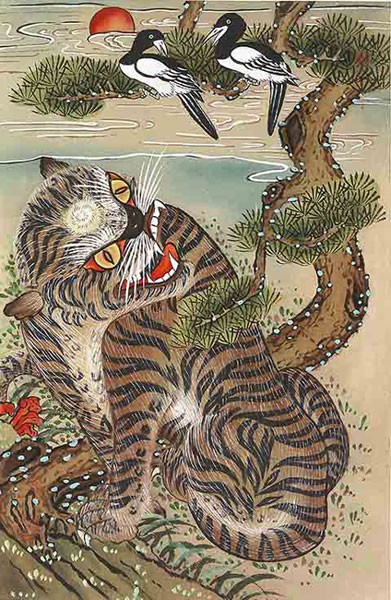 |
The highlight of the exhibition lies in a painting featuring a tiger and two magpies. (Photo: VOV/Dieu Ha)
|
Yet the highlight of the exhibition lies in several unique pieces featuring a tiger and magpies, which really stand out for their sophisticated detail, colors, and layout. The featured artist of the exhibition, Jung Seung Hui, explained that the paintings of tigers and magpies are distinctive and cannot be found in any other country. She says:“When you look at the painting, you can feel the typical Korean humor and satire in it. The tiger here does not look like a normal fearsome and scary one but more like a friendly and funny cat. We believe it would keep the evil spirits away. And above it is the magpie perching on a branch, which Koreans believe can bring good news or precious friends. So families in Korea would hang a painting like this at the front door to keep luck and happiness.”
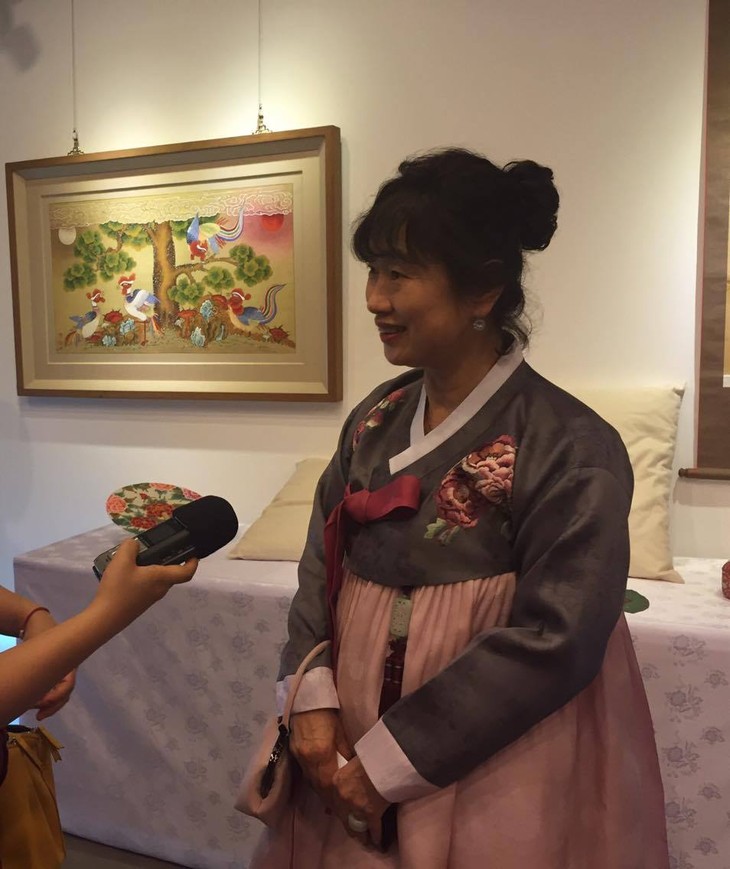 |
The featured artist of the exhibition Jung Seung Hui speaks to VOV reporter at the opening ceremony (Photo: VOV/Duc Hoan)
|
Minhwa, literally means "painting of the people" or "popular painting", were produced and popularized by anonymous painters of the lower class during the late Joseon dynasty of 1390s to 1890s. Though these masterpieces may differ in figures, colors and topics, they are all drawn to a specific plain, straightforward and naive style. Some even look quite childish and unrefined. However, the actual work is much more complicated than that. Jung Seung Hui said:“I started my career in Minhwa art when I graduated from university. At that time, there was no official academic program that specialized in this folk style so I had to study the art for myself. I used to think it would be easy to create these paintings but after 40 years working with it, I realize that the creativity in Minhwa is endless and no one can actually master it. It’s like a challenging mountain that is very hard to climb. But I believe it’s my duty to protect this precious traditional Korean folk art.”
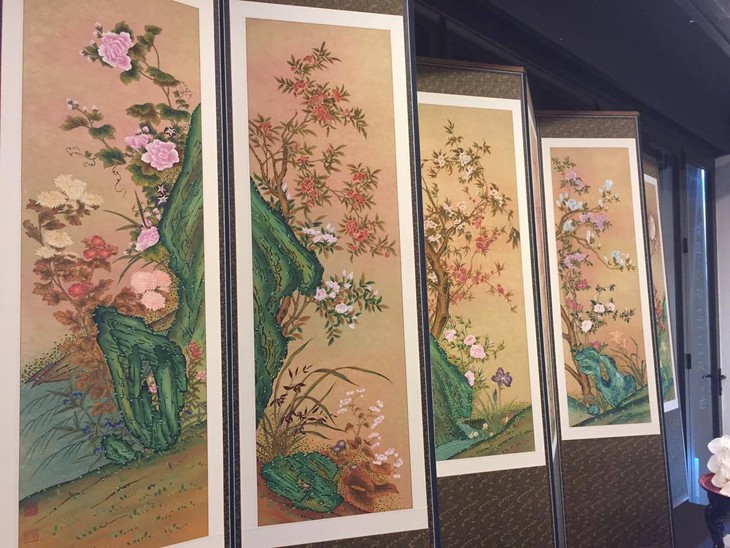 |
It took artisan Jung up to 2 years to paint this large panel-folding scene (Photo: VOV/Duc Hoan)
|
Minhwa is usually produced to decorate the main door of a house or can be done on folded screens and other furniture to bring happiness, luck, prosperity, wealth, fame, offspring, and even to ward off evil spirits. It usually takes a huge amount of effort, concentration and great skill to finish a Minhwa painting. Artisan Jung Seung Hui continues:“The papers used to paint Minhwa art are traditional Korean hanji papers made from hundreds of layers of natural glue paint and wet paper. In the past, we used to paint Minhwa with colors purely from nature. However, as they easily fade, we now mix them with other long-lasting materials to maintain the paintings. It took me 7 - 15 days to finish a small Minhwa piece but for a larger piece such as this panel-folding scene, it took up to 2 years to create”.
Though they are roughly drawn, they express the philosophy of art of the Koreans: bold strokes, vivid colors, and unconventional layouts, combined with wit, humor, and an optimistic spirit. Minhwa paintings are outlined by modeling an original base which is quite similar to the traditional Hang Trong of Vietnam. Vi Kien Thanh, Head of the Fine Arts, Photography and Exhibition Department, speaks at the opening ceremony of the exhibition: “Vietnam’s traditional Hang Trong painting and Korea’s Minhwa folk art have many similarities such as the artists’ view, the portrayed objects and even the style of painting. The craftsman starts with woodblocks to print the outline before drawing the details and coloring the picture by hand. The exhibition shows the remarkable responsibility, love, respect and preservation of Korean people towards Minhwa art.”
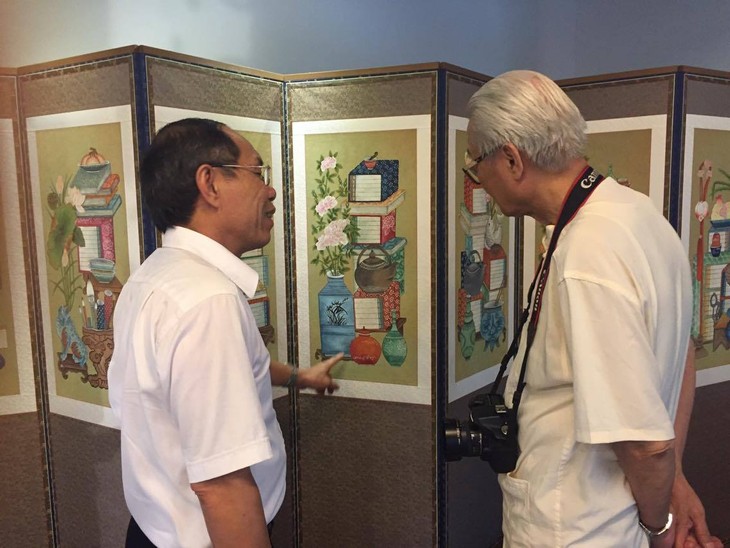 |
Exhibition goers are admiring a large 8-piece panel-folding scene featuring stationeries, symbolising scholars' dream (Photo: VOV/Duc Hoan)
|
Folk paintings portray animals, beautiful flowers, trees, birds and even shelves with books, painting essentials or other daily objects in the live of ordinary Koreans. Luong Xuan Doan, vice Chair of the Vietnam Fine Arts Association says: “I have been working with the Korean Cultural Center in Hanoi for a decade and have visited many of its exhibitions, both modern and traditional. You see, every country has its own folk creativity and here, Korea’s creativity produces paintings with an irresistible visual attraction, and a meaningful philosophy portraying their view of mankind for many centuries.”
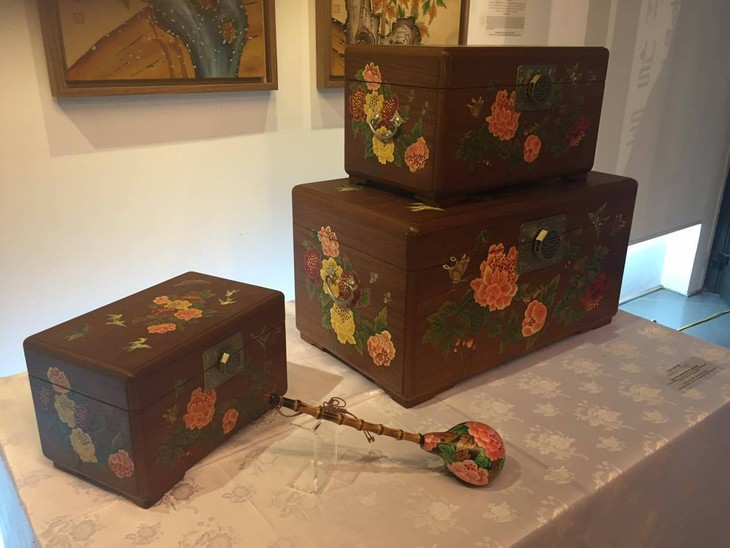 |
Minhwa motiffs can now be found in many daily objects such as boxes, which are also on display at the exhibition (Photo: VOV/Duc Hoan)
|
More than a century ago, the art form was underestimated and viewed as a sign of extravagance. Compared with the art produced for the royal court of the Joseon dynasty, folk art was looked down on. However, this art is now reborn with efforts made by the Korean government, artisans and the people. Minhwa motiffs can now be found on the sidewalk, walls of old neighborhoods, car stickers, mobile phone cases, and school supplies in a way that reflects the changing values and culture. Artisan Jung Seung Hui says:“When I started painting Minhwa art, there were only 5 Korean artisans who specialized in this style. But now the number has risen up to 300,000 people, including artists and scholars. The actual number in fact maybe even higher because some artisans only work anonymously. My teacher,Kim Man Hui, the only Korean artist recognized as intangible cultural heritage Number 18, is now 87 and has to pass down the work to his students like me. But I am sure that there are many more who create and paint Minhwa folk art.”
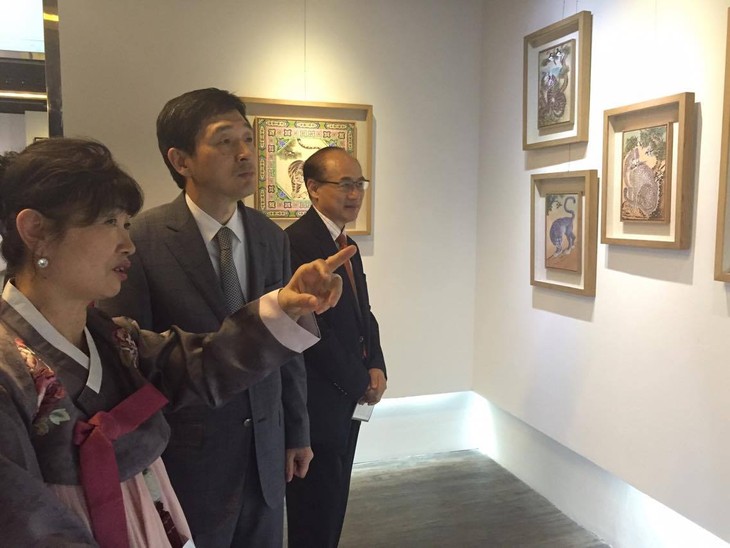 |
Artisan Jung Seung Hui introduces Korean Ambassador to Vietnam Min Huyk to some of her works at the exhibition (Photo: VOV/Duc Hoan)
|
It’s no exaggeration to say that the extraordinary, unconventional Minhwa art illustrates the common Koreans' freedom of expression and reveals their innermost thoughts and dreams. By definition, Minhwa is the artwork of the common people. As long as people exist, so will their folk art. Korean Ambassador to Vietnam Min Huyk appreciates these traditional values: “After being briefly introduced to these paintings, I feel like it’s a harmony of the creativity, imagination and wonderful artistic feeling of the Korean people. Minhwa art even influences modern Korean culture in every aspect, including k-pop, cinematography, music and TV drama.”